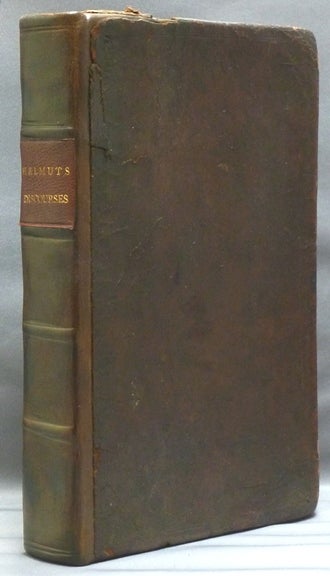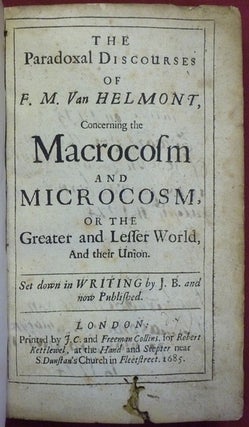The Paradoxal Discourses of F. M. Van Helmont, concerning the Macrocosm and Microcosm, or the Greater and Lesser World, and their Union. Set down in writing by J. B. and now Published.
London: J. C. and Freeman Collins for Robert Kettlewel, 1685. First Edition. Hardcover, 8vo. (xvi) +1 - 127 [128] 1 - 215 [216]pp. Errata on final leaf. Two plates between pages 18 & 19 and 22 & 23 of the second part. Contemporary blindstamped calf boards, recently rebacked with a leather title-label. Later endpapers.
Francis Mercurius Van Helmont (1614 - 1699 CE), was a son of the renowned Flemish chemist, physiologist, and physician, Jean Baptiste Van Helmont (1577 - 1644), whose works he edited and published. He was well known in the European intellectual world of his time, and became the tutor and friend to Leibniz (who wrote his epitaph). He was also friendly with the Cambridge Platonists, notably Henry More and the remarkable Anne Conway, who he introduced to Kabbalism (in Platonised form) and Quakerism, and whose work he also published. Francis Mercurius was profoundly interested in the Kabbalah, and it is now generally acknowledged that he was extensively involved with Knorr von Rosenroth in the publication of the collection of Kabblisitic text that were translated into Latin as the Kabbala Denudata (1677-78), a work which became the main resource on the Kabbalah for Hermetic Kabbalists for centuries to come. The 'Paradoxal Discourses,' is essentially a series of philosophical / theological / medical / scientific essays. They clearly demonstrate a world-view in which everything is both a vital living object or entity in it's own right, as well as a part of an ever evolving greater whole, with the influence of Kabbalistic and neo-Platonic thought particularly evident in the Fourth Chapter of the Second Part of the work. Boards a little splayed, a little tightly bound in the recent leather spine, original boards have typical moderate age-wear, but are sound and presentable. Some old worm damage to the bottom margin of the title page and first sixteen leaves. It starts out slightly larger than two cigarette ends, and finishes in a pin-prick, and does not effect the text. There is some lengthy, early annotation (dated 1742) on the reverse of the title page and the reverse of the plate showing a foetus, as well as several lines on the verso of the plate depicting the ovaries (annotation dated 1740). A couple of other early marginal notes and inscriptions, including a lengthy one in the margins of the first page of the Preface. Some brown blotches and marks to the pages, but over all the text is clean and the pages supple. Item #33748
Price: $1,850.00




